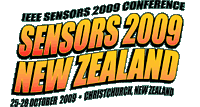

|
Tutorials Micro-Optic and Fiber Optic Sensors Terahertz Sensing Noise Harvesting Chemical and Gas Sensing Industrial Tomography Silicon Piezoresistive Stress Sensors Miniaturised Space Payloads Integrated Gas Sensors Sensors as Communication Channels Nanophotonic Sensors Biopolymer Detection Integrated Radar Sensors Ultrasonics |
The concept of using microwave Doppler radar to detect physiological movements can be traced back to the early 1970s. This technique enables non-contact detection of vital signs of humans or animals from a distance away, without any sensor attached to the body. Compared to infrared or visible light, microwave has greater penetration capability through the building materials, which has a unique potential for many civilian and military applications. The bulky size, cost, and power consumption of early prototype equipment have limited the applications of this technology. Fortunately, recent developments utilizing advanced integrated circuit technologies have demonstrated the feasibility of integrating a radar sensor into portable devices. In this tutorial, historical developments and recent advances of non-contact vital sign detection using Doppler radar will be reviewed. Theory, design, and analysis using various innovative approaches will be presented. The new techniques allow the system to be miniaturized for low cost production and operated with low power consumption, which paves the way for broader applications in science, engineering, medicine, home healthcare, security surveillance, search and rescue, etc. Several prototype examples including bench-top system, portable modules, integrated chips, and their experimental results will be discussed. The experimental results reveal an interesting phenomenon of nonlinear Doppler phase modulation effect. A theoretical model developed to explain the results will be presented. The model can be used to predict the best carrier frequency for vital sign detection, which depends on the body type of subject under test. The theoretical model brings another interesting application of measuring both frequency and amplitude of a periodic motion or vibration accurately, without the need of calibration when the detection distance changes. This suggests that a robust, accurate detection of periodic movements using portable radio frequency devices can be achieved. Experimental results will be presented to verify the concept. Biography Jenshan Lin received the Ph.D. degree in Electrical Engineering from the University of California at Los Angeles (UCLA) in 1994. He joined AT&T Bell Labs (later Lucent Bell Labs), Murray Hill, New Jersey, as a Member of Technical Staff in 1994, and became the Technical Manager of RF and High Speed Circuit Design Research in 2000. From September 2001 to June 2003, he was with Agere Systems, a spin-off from Lucent Technologies. In July 2003, he joined University of Florida as an Associate Professor, and became a Professor in August 2007. He was a Visiting Professor in National Taiwan University in summer 2006. His current research interests include RF system-on-chip and system-in-package integration for sensors, biomedical applications, and wireless energy transmission. Dr. Lin has authored or co-authored over 170 technical publications in refereed journals and conference proceedings. He holds 7 patents. Dr. Lin is an elected Administrative Committee member of IEEE Microwave Theory and Techniques Society since 2006. He is an Associate Editor for the IEEE Transactions on Microwave Theory and Techniques since 2006, and served as the Guest Editor of the Transactions special issue of 2008 RFIC Symposium. He has been serving on several conference steering committees and technical program committees. He was the General Chair of 2008 RFIC Symposium after serving as its Technical Program Co-Chair in 2006 and 2007. He was the Technical Program Chair of 2009 Radio and Wireless Symposium. Dr. Lin received 1994 UCLA Outstanding Ph.D. Award, 1997 ETA KAPPA NU Outstanding Young Electrical Engineer Honorable Mention Award, and 2007 IEEE MTT-S N. Walter Cox Award. He is co-author/advisor of several best student paper awards. |
|||||||
Copyright 2008, All Rights Reserved, IEEE Sensors 2009 and interteq.com